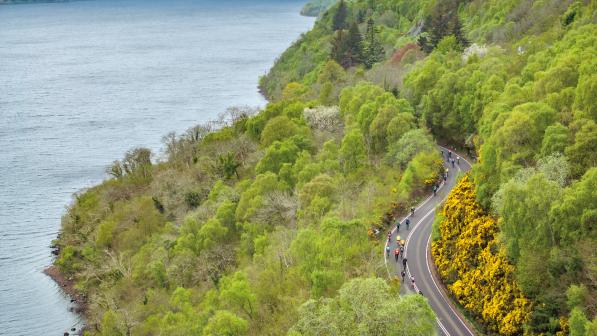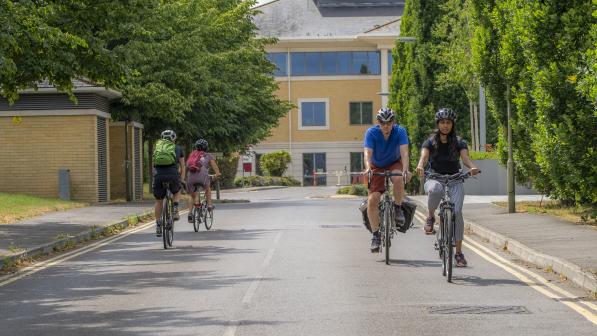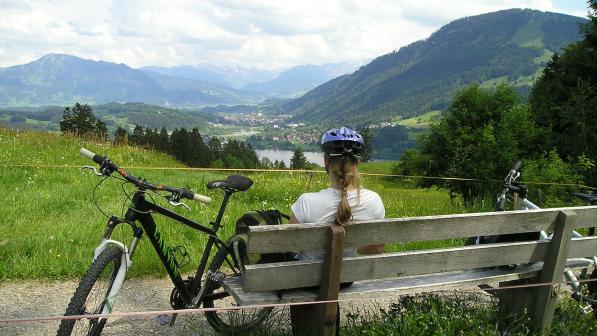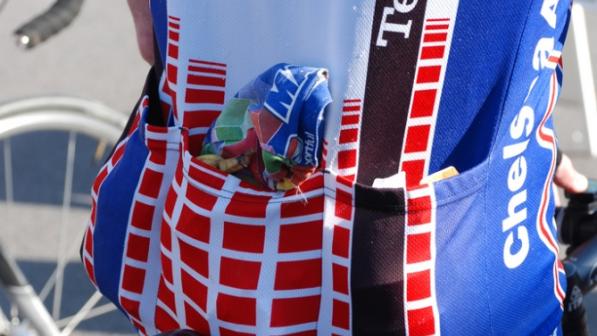A beginners’ guide to … what to eat on a long bike ride

Maybe you ride to work or the shops regularly and you’re thinking about going on some longer leisure rides. Or you want to join a cycling club which organises longer rides than you’re used to.
If you cycle regularly, you’re probably already fit enough to tackle the distance – but do be aware of your own limitations. It’s always best to start small – maybe just a few kilometres further than your usual commute – and build up.
One thing you should think about, though, is how to properly fuel your ride. If you’re used to shorter rides to work or the shops, this has probably never even crossed your mind but longer rides often require an eating strategy.
Getting your nutrition right will improve your performance, ensure you enjoy your ride and help you avoid the dreaded ‘bonk’ – a sudden drop in energy levels, causing you to feel weak, shaky and unable to continue. It’ll also mean you can get on with your day after the ride with plenty of energy.
This advice covers what to eat on longer rides of up to around three or four hours – it’s not for endurance events, audaxes or sportives. If you’re planning on an all-day ride, this advice should still work – just do more of the same.
Please keep in mind that everybody is different and what works for someone else might not work for you. The advice given below is general – experiment to find out what’s best for you. This isn’t medical advice and if you have any doubts, talk to your GP.

A note on hydration
This guide concentrates on food, but you will have to make sure you drink enough too. If you usually only ride up to an hour or so, a single of bottle of water has probably seen you right.
On longer rides though, you’ll need to replace electrolytes as well as water. These are essential minerals such as sodium, potassium, calcium, magnesium, chloride, phosphate and bicarbonate that get sweated out along with water.
It’s a good idea to have one bottle of plain water and one with an electrolyte tablet or powder – or use a sports drink. For the first hour to 90 minutes, you can drink from the plain water, but after that alternate between the two.
How much water you need depends on how much you sweat, how hot it is, how far and fast you’re going and more. However, as a rule of thumb you should aim for around 500ml per hour.
It’s best to sip sparingly but regularly rather than gulping it down to ensure you don’t overdo it. It’s possible – though rare – to overhydrate which is just as bad for you as dehydration.
If you’re riding for a long time, in hot weather or you tend to sweat a lot, pack some spare tablets or powder to use when you top up your bottles. You can ask at a friendly café for water – just be sure to buy something too.
The science bit
Macronutrients are the food components your body needs to keep going. There are three main ones which you’ve probably heard of: protein, fat and carbohydrate. Your body’s main source of fuel is carbohydrate, stored in the form of glycogen – especially on long rides.
For shorter, more intense rides, you might use fat, but burning carbs is a lot more efficient as glycogen is more readily available, so your body will switch to this on those long rides. However, you can only store around 90 minutes’ worth of glycogen. After 90 minutes of cycling, you’ll have used up those stores and find your performance starting to drop.
This is why you’ve probably never thought about nutrition on those shorter commutes. You’ll have sufficient glycogen stores to keep you going. It’s also why you need to think about nutrition on longer rides – you’ll soon run out of energy, which will affect your performance and your enjoyment.
Protein isn’t used as fuel. Instead, it’s the building blocks of your muscles – you need it to properly recover from that long ride and go about your day.
Before the ride
For shorter rides, under 90 minutes, what you’ve got in your glycogen stores should be sufficient to give you plenty of energy to get to work or the shops. I don’t even have breakfast before riding to the Cycling UK office, just a cup of tea and some fruit juice. I eat when I get there (a bagel with avocado and some seeds, since you didn’t ask).
For longer rides, however, you want to ensure those stores are full. This can even start the night before the ride – especially if you’re planning on spending several hours in the saddle. A carb-rich meal with some healthy fats in the evening (not too late, as you don’t want it to interfere with your sleep) and a similarly carb-rich breakfast will set you up.
This could include pasta and sauce, jacket potato with cottage cheese and some steamed vegetables or risotto for dinner. For breakfast, my bagel with avocado is a good shout – it provides plenty of carbs along with healthy fats from the avo – but you could also try porridge with a chopped-up banana or dried apricots, fruit and yogurt or toast with nut butter and jam.
During the ride
This is the important bit. For any ride up to an hour you don’t need to think about fuelling – you’ll have sufficient energy in reserve. Up to an hour and a half, you might want to boost energy levels with a banana or energy gel, but you don’t need to. Just make sure you drink sufficient water.
However, after an hour and a half, your stored glycogen will be depleted. You’ll be able to carry on, but you won’t be at your best, both physically and mentally. It’s best to start topping up those energy levels straight away so you’re not playing catch up and possibly hitting the wall, or ‘bonking’.
Your body can only absorb 60g of carbohydrate from glucose per hour. If you consume more than this, it’ll be stored as fat, and you’ll risk causing yourself digestive issues.
You might sometimes see professional racers or endurance riders taking up to 90g per hour. This is because they’re consuming a mix of glucose and fructose, the sugars from fruits, 30g of which can be absorbed per hour. These different types of sugar use different transporters so more can be absorbed.
Unless you’re a professional athlete, though, this isn’t something you need to think about. You’d also have to train your body to absorb such high levels of carbs without making yourself ill.

For rides of about 2-3 hours, you should aim to consume around 30g of carbs per hour; for more than this, up this to around 60g per hour. As with drinking water, it’s best to do this little and often rather than all in one go.
But what is 60g of carbs?
This is all well and good, but for most of us ‘60g of carbs’ is meaningless – and no one wants to be standing in the supermarket staring at the back of a packet trying to work out how much you need to hit that magical 60.
If you’re consuming energy gels, then the packet will explain the nutrient levels, but if you prefer to get your energy from real food – and there’s no reason not to – then it can be trickier to work it out.
You’ll get 60g of carbohydrate from a banana, half a flapjack, 100g slice of fruit cake, fig roll or malt loaf, a bagel, one sweet potato brownie, 100g of dried apricots, 125g of raisins, 125g grapes, two-three apples, 100g oats, or three slices wholewheat bread.
These are all relatively easy to eat while on the bike. Rice cakes are also good, but you’ll need eight or nine of them to get to 60g of carbs. Other foods could include nut butter and jam or cheese and marmite sandwiches.
This means that if your ride is two to two and a half hours, with a café stop halfway, then a coffee and slice of fruit cake will see you right. For longer than that, an additional banana, a handful of dried apricots or a bagel would be plenty to keep you feeling strong.

For rides over three hours, you’ll need to pack more accordingly, and what works for you will differ from what works for others. Experiment with different foods to figure out which you like best. It’s a good idea to take a mix of foods, especially on longer rides, so you don’t get bored.
What you should eat depends on what you enjoy (you’re the one eating it after all), how easy it is to pack in your bags or pockets (anything squishy or melty is likely to end up a sticky mess) and how easy it is to eat while riding.
After the ride
What you eat after your ride will help with your recovery and how well you feel for the rest of the day, and even how well you can perform the following day. This is where protein comes into its own.
All that cycling will have depleted your muscles, and they’ll need protein to regrow. Your energy stores will also be depleted so don’t neglect carbs either.
Eat a decent meal that includes protein, carbohydrate and ideally some healthy fats within an hour of finishing your ride. This could be something like a chicken breast, omelette or tofu steak with a jacket potato and side salad that includes avocado and a healthy drizzle of extra virgin olive oil. Oily fish like tuna or salmon are also good sources of protein.
Nuts and seeds provide protein, fibre and healthy fats, so a slice of nut roast with sweet potato and some steamed broccoli and cauliflower would be a great plant-based recovery meal.

Gels and bars vs real food
I personally prefer real food – who wouldn’t want a nice homemade flapjack with freeze-dried raspberries and white chocolate chips rather than a gel? But that’s not to say that energy gels, bars and drinks don’t have their place. I’ve used them on long sportives, as well as making full use of the feed stations.
They’re easy to stash away in a pocket or bag and they’re easy to eat on the go. They’re easily digestible and don’t leave you feeling bloated, making them a good option for anyone who has stomach issues.
If you’re on an all-day ride, a mix of real food and energy gels and bars will help ensure you get sufficient carbohydrate to keep your glycogen levels up without feeling overly full or getting bored. And if you haven’t got time for that recovery meal, then a protein-rich energy drink is a good way to start repairing those muscles.
From our forum
The Cycling UK forum is an excellent source of all kinds of advice, and I asked members to share some of their top tips for what to eat on a long ride. It kicked off quite a discussion and I’d like to thank everyone for taking part. Here are just a few of my favourites.
Carlton green: “My top and inexpensive tip, for what little it’s worth, is to have a drink and a biscuit – or two – well before you get tired enough to (find you) need them.”
roubaixtuesday: “My advice would be:
(1) You don’t need to eat anything special. Eat things you enjoy – it doesn’t matter what.
(2) Easy-to-carry robust things are best if it’s being carried, e.g. flapjacks, trail mix. Slices of Victoria sponge, not so much.
(3) It’s good to have a little sweet treat to make you feel better if flagging. Jelly babies are great.
(4) A decent stop on a long ride, whether café or packed lunch helps enjoyment.”

mattheus: “OK:
- Nuts (unless allergic!), come in a variety of flavours.
- Mini pork pies.
- Vegan versions of above (which are now a million times tastier than ~10 years ago, and probably healthier).
- (If sat in a café): beans on toast. The brunch of (cycling) champions. An excellent source of essential amino acids, plus some slow-release carbs.
- Fruit.”
Pendodave: “If I’m cycling at a reasonable pace and distance, I can’t eat anything heavy at all. So I’m just after high-carb lightweight stuff. Jelly babies, peanut butter sandwiches, flapjacks, cakes. Little and often.
I think that practicing what you eat on a cycling day is important – individual guts digest food very differently and finding out that yours doesn’t like something is a tough thing halfway through a long day.”
deeferdonk: “Unscientific but here’s what I do:
For my weekend rides up to 50 miles I factor in a café stop about halfway and have a cup of tea and sandwich or cake or similar.
Emergency pack of Haribo in handlebar bag to grab a couple if I do feel myself start to flag (or sometimes it’s just nice to eat some Haribo!).”
drossall: “Carry a snack that you like – banana, energy bar, other less technical bar, whatever takes your fancy and again is something you know you can eat easily. Cyclists used to swear by Mars bars, not that there aren't better options now. For many cyclists, the café stop is part of the ride, so ride a bit further than your commuting trip to a suitably located café, have a tea/coffee and a tea cake or something, and ride home again, and you probably won’t need the energy bar.”
Read the whole thread for even more tips and advice. And while you’re there, why not register to share your own thoughts?
However, some of the best advice that everyone agreed on was: don’t overthink it! For most rides, a bottle of water, a café stop and a spare banana will see you right. The most important thing is to enjoy the ride!



